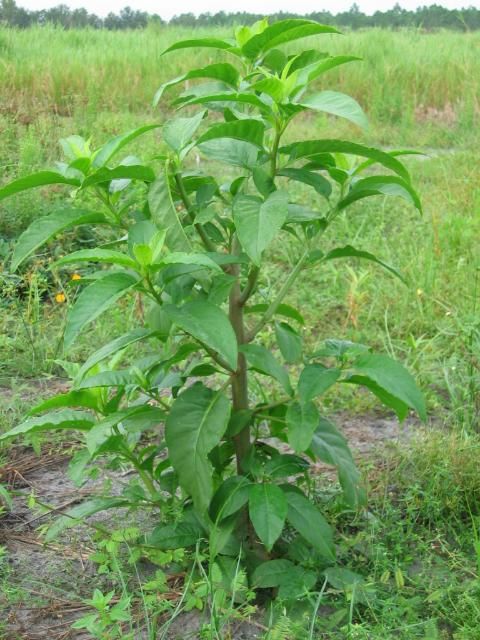Common pokeweed (Phytolacca americana), a native of North America, is a perennial weed often found in pastures as well as fence-rows, rights-of-way, reduced-tillage row crop fields, and wooded areas. It occurs from Maine to Florida and as far west as Texas. Other names for common pokeweed include: poke berry, pigeon berry, inkberry coakun, pocan bush, scoke, poke salad, and American nightshade.
Biology
Once common pokeweed becomes established, it regrows each year from a large, fleshy taproot. The crown of the root is where the plant is regenerated and can be as large as 5-1/2 inches in diameter at the soil surface within two growing seasons. Pokeweed usually has a red trunk-like stem, which becomes hollow as the plant matures. Leaves tend to be quite large (10 inches long), alternate, ovate-shaped, dark green, and attached to the stem by a red, fleshy petiole (Figure 1). When flowering, individual flowers appear green to white and are typically without petals (what you see are the sepals). Fruits are green when immature and turn a deep purple to black at maturity. Each fruit contains approximately 9 seeds. Additionally, plants can produce anywhere from a few thousand seeds to over 48,000 seeds per plant. Seeds can remain viable in the soil for over 40 years.

Credit: B. A. Sellers
Toxins
While pokeweed is rarely considered a noxious weed, it can cause harm in certain situations. All parts of the plant contain saponins, oxalates, and phytolacine (an alkaloid). However, the roots and seeds contain the highest concentrations of these toxins. Depending on the quantity of plant consumed, livestock may exhibit mild to severe colic and diarrhea. Hogs are most affected by rooting up and eating the root. Additionally, sheep, cattle, horses, and poultry are susceptible to pokeweed poisoning, but they are not usually affected as the plant is not readily consumed by livestock. Birds eat the fruits without much harm and are usually the means for seed dispersal along fence rows, under utility lines and wooded areas.
Cultural Uses
Although pokeweed can cause severe poisoning in humans, Native Americans once used this plant as a heart stimulant and as a narcotic. The plant also contains a protein that has been shown to have a positive impact on HIV, a precursor to the AIDS virus. Additionally, many people cut young shoots and leaves and eat the plant as one would eat asparagus, thus the name poke salad. For human consumption, the plant must be boiled at least two times in water and the water must be removed before eating. Some say that an additional boiling will essentially remove all toxins in the plant material.
Some may actually want to plant this weed for human consumption. To do so, gather about a pint of the purple berries, crush them, cover with water, and let ferment for a few days. Viable seeds will settle to the bottom and the pulp and skins can be floated off and discarded. Then spread the seeds out until dry and store them in a cool place. When time to plant, soak the seeds in concentrated sulfuric acid to break dormancy and speed germination, while following all safety guidelines for using concentrated sulfuric acid. After 5 minutes, pour the solution off and thoroughly wash the seeds in running water. Dry the seeds once again before planting. Sow seed early in the spring in rows 4 feet apart and cover shallowly. After germination, seedlings should be thinned to about 3 feet apart in the row.
Control
Control of common pokeweed is typically not easy because of the large fleshy crown and associated taproot. Except in some row-crop situations, pokeweed rarely infests large areas and is usually found in isolated instances. Removal of individual plants is accomplished by wholly removing the crown and a major portion of the associated taproot. Alternatively, spot applications of glyphosate (3% volume/volume) or products containing 2,4-D or dicamba can severely injure or kill the plant.